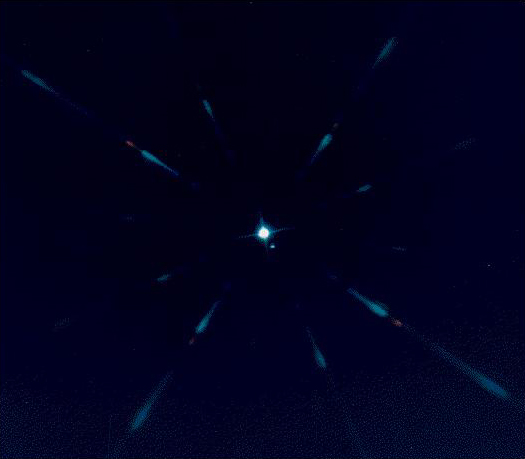This guide is written to give hints to people who already know approximately what they’re looking at. For a good beginner’s guide to the sky, try StarDate [1], Sky and Telescope’s Stargazing Basics [2], or Sky and Telescope’s links to lots of beginning topics [3]. (Or, if you know a better beginning stargazing site, put a link to it in a comment below!
Notable Sky Objects
VENUS
It may not be on my map, because the map is for later in the evening, but Venus is spectacular low in the southwest just after sunset. If you’ve got clear enough skies, poke your head out and learn why Venus has earned the moniker “the evening star.” (In a couple months you’ll be able to poke your head out early in the morning and learn why Venus ALSO earned the moniker “the morning star.”)
New Constellations
CANIS MAJOR – The Big Dog
SCIENCE: Obviously you’ll need to notice Sirius, the brightest star in the night-time sky, and if you’re wondering about that other one nearby, that’s Procyon. It’s not in Canis Major, it’s in Canis Minor (the little dog), but it’s nearby. If you have a new telescope (or an old one), Sirius might be a fun target, it’s bright enough to find with your scope semi-easily, and it’s a double star, so once you find it look for the teeeeensy-tinsey companion star. (I say “semi-easily” because learning to point a scope takes practice).
MYTH: Traditionally Canis Major and Minor are known as Orion’s hunting dogs, but children today will recognize something else in this constellation. The star Sirius is the inspiration behind the name of J.K. Rowling’s character Sirius Black in the Harry Potter series. Sirius Black is an animagus, a man who can turn himself into an animal. Guess what animal he becomes? Yup – a dog. A big, black dog. She knew her stuff.
According to Dr. Snowder at the Western Washington University Planetarium [6], the Chinook Tribe sees a canoe race in this part of the sky:
“A big canoe (Orion’s belt) and a small canoe (Orion’s dagger) are in a race to see who can be the first to catch a salmon in the Big River (Milky Way). The little canoe is winning the race. Can you tell which star is the fish? It is the very bright star in the middle of the river (Sirius).”
CANCER – The Crab
SCIENCE: Oh beautiful M44! Messier Object #44, the Beehive Cluster, is in the middle of Cancer. I have been told it’s called the Beehive because it’s full of little triangles of stars which look like bees swarming around.
MYTH: The ancient Egyptians saw Cancer as a scarab beetle – a symbol of life and immortality.
LEO – The Lion
SCIENCE: The star Wolf 359 is in Leo. It’s the third closest star to the Sun – and you might remember it from Star Trek fame – the Battle of Wolf 359, where the Federation attempts to hold off a Borg attack. The other closest stars are Alpha Centauri and Barnard’s Star. It’s too dim to see without a telescope or a camera, but it would be between Leo’s front and back feet.
Gliese 436 (I know, terrible names) is ALSO in Leo. There may be a small Earth-ish-like planet around this one – there’s definitely a Neptune-ish-like planet. We talked about a similar discovery a while ago [8] – and this discovery is by the same team [9].
MYTH: The Khoisan people of South Africa call Regulus the “Fire Finisher.” It is a star that marks the time of night in the winter. Unfortunately, in the paper I read, the Fire Finisher might also be Antares or Arcturus – depending on which tribe you ask. Regulus is called “G/wi” – and I’m sorry, I can’t help you pronounce that, the “/” is an actual part of the anglicized spelling, because the Khoisan languages are the “clicky” languages of the San (Bushman) people. (This is from Astronomy Across Cultures, a book of scientific papers on traditional astronomy around the world. It’s an awesome book, and VERY hard to get a hold of).
“Tiny” Guys
Going for the Gold? Here’s this month’s itty-bittys.
LEPUS – The Hare
ERIDANUS – The River (Actually, it’s huge, but dim)
CANIS MINOR – The Little Dog
LEO MINOR – The Small Lion (Between the Big Dipper and Leo)
CAMELOPARDALIS– The Giraffe
TRIANGULUM – The Triangle
ARIES – The Ram
SEXTANS – The Sextant
HYDRA – The Sea Serpent (Also big and dim, so big that it may be the biggest Northern Hemisphere constellation)
MONOCEROS – The Unicorn
LYNX – The Lynx
LACERTA – The Lizard
Returning Constellations
ORION – The Hunter
TAURUS – The Bull
GEMINI – The Twins
PISCES – The Fish
ANDROMEDA – Princess Andromeda
PEGASUS – The Winged Horse
CEPHEUS – King Cepheus
DRACO – The Dragon
URSA MAJOR – The Great Bear
URSA MINOR – The Little Bear
CASSIOPEIA – The Queen
Happy Sky Viewing!
Where’d I get my Info?
My memory, and Zeta Strickland
Selin, Helaine ed. Astronomy Across Cultures. Kluwer Academic Publishers. 2000.


